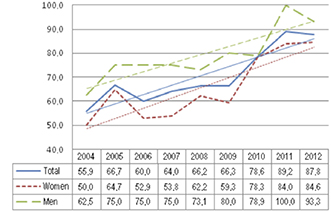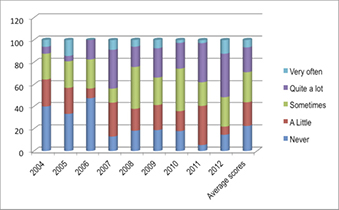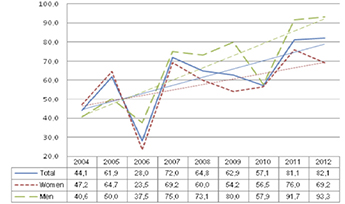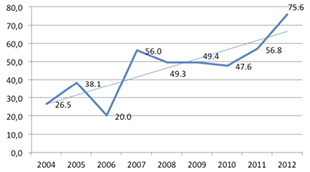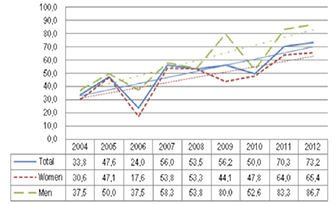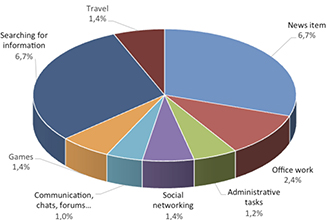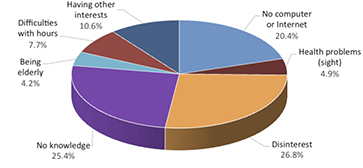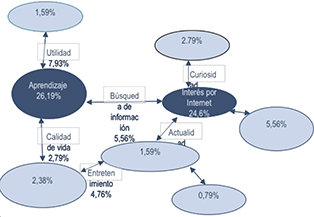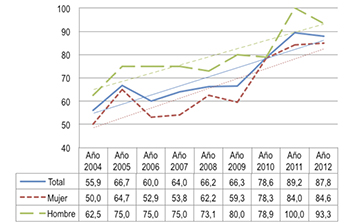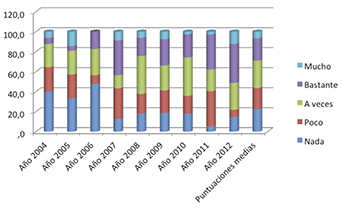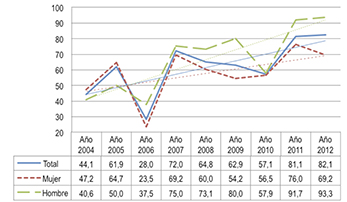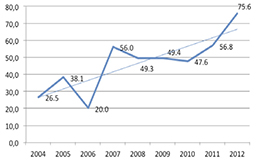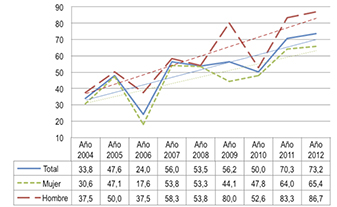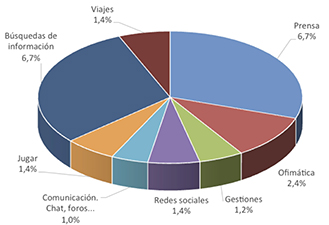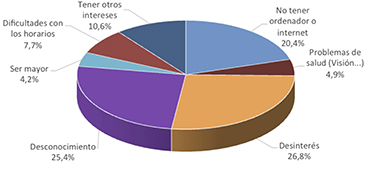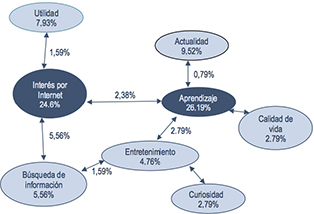Pulsa aquí para ver la versión en Español (ES)
Abstract
Researchers' interest in seeing the benefits of Internet in elderly people is now growing. The network helps this group to increase communication, avoid isolation and loneliness and to age actively. Europe decided 2012 to be the Year of Active ageing. This paper presents a descriptive study of time series analysis carried out between 2004 and 2012 with the aim of knowing how the evolution in the level, motives and needs of the use of computers and Internet by elderly people in an environment of university training focused on health and life quality is. To obtain results a question paper is to be handed out to a sample of 419 people aged between 55 and 94 and taking part in the «Inter-university Programs of Experiences» from the University of Burgos. The obtained results match up with previous studies that pointed a noticeable increase in the use of the Internet (in frequency, number of users and resources) caused by elderly people's desire to keep active, up-to-date and communicated, as well as their need to continue their learning process through tools linked to the network. Here some suggestions focused on the improvement elderly people's formation and future research on the perception of the Internet as a tool for social participation.
1. Introduction and state of the question
We live in an information and communication society that has laid the groundwork for the so-called knowledge society (UNESCO, 2011). The technological advances that drive that society are swift, unceasing... Adapting to their speed, on occasions, causes vertigo. On the contrary, not adapting to them means sitting out the game on the touchline, and failing to adapt never favours personal health. We may therefore also talk about technologies and the health of older people, knowing that their needs and concerns as users of technological means of communication (computers, smartphones, tablets..) differ from those of younger people (Wagner, Hassanein & Head, 2010), while acknowledging that education helps to overcome those difficulties (Bélanger & Carter, 2011; Salvador, 2003).
Support for lifelong learning (Field, 2006) is also a common theme nowadays. In Spain, we found programmes for adults over 55 years of age, such as the University of Experience or the University for Older People, in both public and private universities. In particular, the Interuniversity Programme of Experience has been up and running since 2002/2003 in the Autonomous Region of Castilla y León, involving all of its universities. These institutions provide a common educational programme aimed at older people, with the collaboration of the regional social services (Palmero & Jiménez, 2008); learning among older people is promoted to strengthen active ageing. The WHO (2002, 2012) defines the concept of active ageing as an ongoing process of optimizing opportunities for health, participation, and security, in order to enhance quality of life as people age, facilitating active ageing in better conditions. The process is of such relevance that Europe dedicated 2012 to its promotion and its objectives are still alive today.
Education for health is a potent tool with which to encourage active ageing (Davey, 2002), traditionally developed in the classroom and now linked to virtual environments.
Active participation in technological environments can play an essential role in the improvement of health and quality of life for older people (Blazun, Saranto & Rissanen, 2012; Chen, Lee & Kirk, 2013; Sum, Mathews, Hughes & Campbell, 2008): 1) Favouring independence and creativity; 2) Creating new social networks and avoiding isolation and loneliness in society; 3) Allowing access to services related to health, culture, etc. Gracia and Herrero (2008) found that older Internet users maintained better physical health, experienced fewer problems associated with mental illness and showed higher levels of integration and participation than non-users. Meneses, Valente and Rodríguez (2004) confirmed that social activity on the Internet was not incompatible with face-to-face social activity, but that both forms of participation appeared to have similar effects.
The degree of Internet penetration in the population of older people varies notably. In the United States, Fox (2004) pointed out that 22% of Internet users were over 65 years old and around 44% were between 59 and 68 years old. Recently, Zickuhr and Madden (2012) pointed out that half of the people over the age of 65 in the United States, are already on-line. According to Eurostat (2012), in 2010, about 17% of Europeans aged between 65 and 74 were using the Internet in the Union of the 27 Member States. As of 2007, in Spain, 5.1% of users were aged between 65 and 74, and only 1.5% were older than 75 (INE, 2011; Red.es, 2012). The differences are even larger by gender.
Internet use among older people continues to be low in certain countries, so much so that they have been identified, together with disabled people, as those at greater risk of exclusion in the information society (Dobransky & Hargittai, 2006; Watling, 2011). The so-called digital divide increases, as people age (Fundación Vodafone España, 2011) and it constitutes a significant concern for professionals that work with this population (Abad-Alcalá, 2014). Low levels of computer literacy (Xie, 2011) is due to a multicausal effect. Wang, Rau & Salvendy (2011) found that perceived utility was the most important variable with which to predict the acceptance of technology, followed by ease of use.
In Spain, the Observatorio Fundación Vodafone-CERMI (2011) showed that the main reasons for the low use of technology are poor appreciation of its use in one’s daily life; functional limitations; and economic limitations. Nevertheless, despite the barriers that they encounter, older people wish to learn (Aguiar & al. 2003).
Training in computer literacy is therefore needed by users (Norman & Skinner 2006; Xie, 2011). However, it is also noted that web designs are not usually well adapted, as problems of accessibility arise (European Commission, 2010; Czaja & al., 2013; Observatorio Fundación Vodafone-CERMI, 2011). The most significant difficulties found refer to small font sizes, an excess of information on each page, and a lack of clear instructions. Emphasis is therefore placed on the need to have codes of conduct for the improvement of web pages (Miller & Bell, 2012). As teachers of Education for Health, our interest in education, health and technology led us to propose a practical problem as part of the Interuniversity Programme of Experience at the University of Burgos. On this subject, attention has traditionally been paid to topics such as those identified in the programme put forward by Berensson (2007): nutrition, physical activities, accident prevention. But, in the Spanish context at least, we rarely find a relation between the Information and Communications Technology (ICT), particularly the Internet, older people and active ageing. We therefore found it of interest to first understand the relationship that our older people have with ICTs, as a basis for the work in the Health Education classes and, subsequently, to analyse the evolution of that relation.
2. Materials and methods
The design of the research proposal, in response to the objectives of the study, was correlational and descriptive in nature, with information collected over 9 years, equivalent to 8 academic years (2004/05 to 2011/12). The proposed objectives are:
• To establish the evolution, from 2004 to 2012, of the development of basic ICT indicators (availability and use) in a population segment (people older than 55 years enrolled on programmes of experience at the University) defined by their age and cultural interest.
• To identify the reasons that these older people give for using or not using the Internet.
• To detect the main learning needs/desires of older people regarding the use of the Internet.
We designed an ad-hoc questionnaire, in order to collect information on these variables, without an excessively high number of questions (ten), so as not to overtire the older people. The questionnaires directed at this group have to be as short as possible, as older people easily become tired and a long questionnaire might reduce the quality of the test and the response rate (Wang, Rau & Salvendy, 2011). The test was drafted in plain language, to facilitate the understanding of respondents, as they did not constitute a uniform group and differed in academic levels and age, which are diverse factors that have also been highlighted in various works (Gracia & Herrero, 2008; Imserso, 2011).
The contents of the test are related to the standard indicators on the presence of the ICTs in Spanish society (Gracia & Herrero, 2008). The majority of the items were closed questions (possession and use of a computer, Internet use, and place of access…). The open questions were: what activities do you do with the computer? If you do not use the computer, what are your reasons? Would you like to learn to use a computer and to access the Internet? Why?
Expert judgement was applied at two levels to control the validity of the questionnaire: 1) a review of other questionnaires administered to groups of older people (Aguiar & al., 2003, Gracia & Herrero, 2008; Imserso, 2011); and, 2) a final review by a panel of 8 experts directly linked to educational programmes for older people. The reliability of the instrument was 0.847 (Cronbach’s alpha).
In an initial phase, two researchers conducted the process separately, in order to ensure reliability in the coding of the qualitative questions. Subsequently, the results were compared and agreement was reached on the few discrepancies that were found.
2.1. Population and sample
The population under study was constituted by the set of people over 55 years enrolled in the so-called Programme of Experience at the University of Burgos, at its main campuses at Burgos, Miranda de Ebro and Aranda de Duero, over eight academic years (2004/05 to 2011/12). The programme has received public funding from the Junta de Castilla y León. The selected sample consisted of 419 people who answered the questionnaire and who were following the «Education for an Active Life» study programme, as part of the Active Ageing and Quality of Life module.
All together 261 women, 62.29% of the sample, and 158 men or 37.71%, responded to the questionnaire.
Their ages varied between 55 and 94 years old. The average age was 65.42; the mode, 62 years old, and the median, 64. The standard deviation yielded a value of 6.18. By intervals, 58.1% of the sample was between 55-65 years of age; 23.9% between 66-70 years of age; 11.9% between 71-75 years of age; and, 6.1% between 76-94 years of age.
As regards the profession (current or pre-retirement) of the participants, we found a very broad variation in the responses; housewives predominated (22.7%) followed by those with jobs in the industrial sector, at 16.4%. Classes were followed in both urban and rural environments: 211 of the people surveyed lived in Burgos (50.36% of the total); 133 in Aranda de Duero (31.74%); and 75 participants lived in Miranda de Ebro (17.9%).
3. Analysis and results
In this section, we explore the results obtained after the application of the descriptive statistical tests that are appropriate for the nature of the variables and the objectives of the study.
• Do you have a computer at home? Although on average, we found that 69.5% of the sample indicated that they had access to a computer at home, observation of the data and its evolution is revealing (figure 1). We noted a clearly positive trend in all cases, presenting an increase, on average, of 31%, which was slightly higher among women (34.6%) than among men (30.8%). Nevertheless, we should point out that the increase remained constant in favour of men (observing a difference of over 10% practically every year), highlighting the disadvantages for women on this point.
Internet access from rural areas maintained these differences by gender, although it was 10% less than in the city.
• Computer ownership. The computer belonged to the survey respondent in 75% of all cases. If we analyse it by gender, 68% of women affirmed that it was their property, as opposed to 84.4% of men. Likewise, it is relevant to study the situation of those people that said the computer was not their own. The alternatives we found were: a) sons/daughters (13%); b) grandson/ granddaughters (0.7 %); c) Others (social organizations…) (0.7 %).
• Use of the computer. With regard to computer use (rated on a 5-point scale from «never» to «very often» in Figure 2), the average scores of the data present a certain balance, given that the values for «never», «a little», and «quite a lot» were very close to 20%, varying substantially from «sometimes» (close to 30%) to «very often» (a little more than 5%). However, when we analysed their temporal evolution, we found a substantial change. Thus, up until 2006, more than 50% of the participants indicated that they used the computer «a little» or «never». From 2008 to 2010, a greater tendency to value its use as mainly «sometimes» was observed. Finally, over the most recent years, 2011 and 2012, it appeared that almost 40% and 50% respectively used it «quite a lot» or «very often». Observing the data over the last 6 years, a rate of around 14% of the sample that «never» used the computer appeared to consolidate itself.
Levels of computer use fell as age increased. So, for the total average by age, the population over 76 years of age that used the computer «a little» or «never» was almost twice as high as that of those between 55 and 65 and those under 75 years of age. We found that those who used it «quite a lot» or «very often» tended to remain over 26%.
• Internet Access. A total of 65.1% of all participants accessed the Internet. We found a significant dependence (Chi Squared=64.22; p=0.000) among those who used the Internet and, at the same time, had a computer at home with an Internet connection. Nevertheless, we would point out that this relation was not statistically significant (Chi squared=3.06; p=0.08), in 2004.
The increase in Internet access, on average around 37.9%, was remarkable given that it was almost seven points higher than the increase in the presence of a computer in the household. However, the evolution of the sample varied notably, when we studied it by gender. Thus, in the case of women, it increased by 22%; while in the case of men, the increase was around 52.7%. The women, in the first few years, were those who accessed the Internet to a greater extent, but at present men surpass them by more than 20% (figure 3). In particular, we found that 57.7% of housewives had access to the Internet.
• Place of Access. On average, 48% of participants connect to the Internet from home. This piece of information reflects the progressive incorporation of Internet access in all homes, including in the case of older people. While, in 2004, 26.5% of participants accessed the Internet from their home, at present more than 75% do so (figure 4, see the next page). In other words, the figure has tripled over the 9 years under discussion.
Other spaces were noted, such as at the University, public libraries, Internet cafés and day-centres for older people, although with very small percentages in all cases. The only highlighted case was the University, which was pointed out by 4% of the sample. The home, therefore, is the real reference for Internet use. In the specific case of housewives, the great majority of them accessed the Internet from the home (73.33%), followed by the University (17.77%).
• Internet activities. We found that the relation between access to the Internet and the use of e-mail was significant and positive (n.s.=0.05). When we merged the two variables in a contingency table and tested the hypothesis of independence with the Chi squared test, we obtained a value of 5.903; which, with one degree of freedom, means that the probability of non-rejection of the hypothesis is 0.015. In other words, there is a relation between both variables, although it is not significant at the level of 0.01. It is curious to observe that among the responses of the 6 older people who stated that they did not access the Internet, they nevertheless did consult their email in 4 cases; a statement that might be a symptom of computer literacy levels.
In summary, the majority of those who accessed the Internet did so mainly to use email. As with access to the Internet, the use of email has increased to a much higher rate among men than among women. The percentage of access of both men and women doubled between 2004 and 2012 (figure 5, see the next page).
After the use of e-mail, the search for information (mainly on: health, cinema, music, and culture), or reading the press on-line, in both cases at 6.7%, represented the most widely practised activities (figure 6). A total of 2.4% reported office work (creative writing, photography), and 1.4% carried out searches related to travel; the same percentage went online to use social networks. This activity has emerged over the last three years: Facebook and Twitter were the most frequently mentioned networks. So, from 2004 to 2008, a small number of users indicated that they used Messenger, a situation that then receded and, we understand, was replaced by more recent synchronic data communication, linked to smartphones, or the aforementioned social networks. A total of 1.2%, men only, indicated that they used this medium for management (e-administration, electronic banking, etc.). Finally, 1% affirmed that they made use of other communication resources (chats and forums) and women related them directly to on-line communication with children.
• If you use neither the computer nor the Internet, what reasons might you give? A total of 34% of the sample that answered this question gave the following reasons (figure 7): lack of interest and lack of knowledge stand out at over 25%. A total of 20.4% indicated as a reason that they had no computer or Internet; reasons directly related to economic aspects. A total of 4.2% associated non-use with being an older person. This point is especially interesting, because that response was only given in the first few years of the study (2004-08). It is surprising that some affirmations are not consistent with the later responses to the same questions. So, for example, 50% of those who expressed lack of interest expressed different arguments later on, to explain why they would like to learn to use the computer and the Internet.
• Would you like to learn to use a computer and to access the Internet? Why? A total of 82.7% of the sample (between 2004 and 2009) of those that made no use of the computer/Internet affirmed that they would like to learn how to use it and only 17.3% said that they would not like to learn how to use it. Figure 8 was constructed, after a coding process, on the basis of the responses to this open question.
The reasons given for wishing to learn are varied and an interest in the Internet may be highlighted, because, among other reasons, it opens new learning possibilities. Further reasons that they gave were: usefulness, the possibility of looking for information, entertainment, curiosity, current affairs and quality of life, as shown in Figure 8, which includes the single percentage response and that shared with other reasons.
4. Discussion and conclusions
Our study has presented a descriptive analysis over nine years, which corroborates that older people with a degree of motivation to remain active in the learning process, evidence of which is their enrolment on Programmes of Experience in the province of Burgos, were increasingly using the computer and accessing the Internet, as has also been reported in other national and international studies (Imserso, 2011; Zickuhr & Madden, 2012). The main point of access is the home, but there are also other points (University, and social centres for instance) (Aguiar & al., 2003). This access from outside the home occurs to a greater extent in the rest of the population in the context of university programmes for older people (Imserso, 2011).
We also found an increase in the presence of computers at home. In 2007, 64% of our sample affirmed that they had one, close to the average in the EU27 (67%) (Red.es, 2012).
Our results differ from the reality of the general population of older people, as according to data from Imserso (2011:489), «only 16.7%» of them «have a computer», set against the figure of 78.6% from our sample in 2010; which shows almost five times more. This may be due to the characteristics of the population that participated in the survey.
Gender influences the presence of a computer in the home: women are clearly in a disadvantaged situation, both as regards the use and ownership of a computer (Imserso, 2011). In some cases, they appear in a somewhat submissive role, sharing that computer when they have one, or assuming that it belongs to the husband; attitudes which the men did not express.
The results match those of previous studies that pointed to a noticeable increase in the use of the Internet (in number of users, frequency, and resources). The Vodafone Foundation, Spain (2010), underlined that housewives and older people of over 80 years of age are the groups most distanced from ICTs. Housewives predominate in the sample of our study, but we have not found that they are distanced from the Internet. On the contrary, they show high levels of participation and evolution. It should however be noted that the study concerns women who have demonstrated an interest in training in general, when attending a university programme.
We have a sample with almost twice as many women as men, but the figures are very different when we see the increase in the use of Internet: it is more than double in the case of men (52.7%) than in the case of women (22%). We may therefore say that «the use of ICT is more extensive among older men than among older women» (Imserso, 2011: 312)
We agree with different studies (Eurostat, 2012; Selwyn, Gorard, Furlong & Madden, 2003), in that the most frequent activity/service is, by far, e-mail consultation. In exactly the same way, we see that the contents by preference refer to culture, leisure and the media. A novelty that our study offers is the emergence of social networks (Facebook, Twitter) and their use in recent years, consistent with present day developments. This line of research starts to arouse interest when wishing to identify the perception of older people with regard to social networks and the educational strategies to teach older people how they may be used (Xie, Watkins, Golbeck & Huang, 2012).
We also found that among those who used the Internet and those who would like to begin to do so, the motivation for the participation in entertainment activities (on-line gaming) is on the increase. If functionality has been key to get closer to the Internet (Wang, Rau & Salendy, 2011), we find a new generation that associates the Internet with enjoyment in their free time, in contrast with other traditional models of leisure in this population.
The majority of our older people, who have no computer at home or do not use one, would like to learn how to use one and to access the Internet, as Gracia and Herrero (2008), and Aguiar and others (2003) also found. The technologies are of interest to them and they believe that they can be updated and that they can learn with them.
The reasons that they give for not using Internet coincide to a great extent with those presented by the Observatorio Fundación Vodafone-CERMI (2011): lack of interest, they do not expect it will contribute anything to their daily routines; they did not have to use computers in their working lives; they were scared of making a mistake and losing all the information; functional limits, etc.; and these reasons relate to the variables for the acceptance of the technology studied by Wang, Rau & Salvendy (2011).
Overall, we believe that we have achieved the proposed objectives, although we find limitations linked to the instrument and the context of its application. The questionnaire did not contemplate different variables (level of education, specific items related to the Internet and to health, etc.), which would have allowed us to broaden the study and look in greater depth at the results, contrasting them with similar studies, given that health is a topic of great interest for older people (Campbell, 2004; Karavidas, Lim & Katsikas, 2005).
With regard to the context, we consider that carrying out the survey in an almost formal education environment (a university classroom) might create insecurity when responding to questions, creating an uneasy feeling if, for instance, they had to declare their level of Internet literacy in front of others. This could lead to responses that reflect «social desirability» rather than reality, a problem of a methodological nature that subsequent studies may consider.
We consider it necessary to stimulate measures that encourage the use of the Internet centred on education, accessibility, and a cross-cutting consideration of the female condition. Any measure, whether educational, technical, or of any other sort, has to consider women and their access to technological resources, in such a way as to advance towards equality, reducing the digital gender divide, as has indeed been happening (Instituto Nacional de Estadística, 2011), and the consideration of gender in active ageing (Foster & Walker, 2013). In our study, we found that the promotion of social relations, among both family (children) and friends, is a priority in the case of women, which may be used as a stimulus so that they gain greater familiarity with the Internet.
It appears that participation in training programmes for older people has been proven to increase the use of ICTs and their gradual inclusion in the household (Imseso, 2011; Xie, 2011). Training in various contexts is proposed in the Programmes of Experience (Pavón, 2000), including a course called «Introduction to the use of the computer and the Internet», directed at all students; moreover, increasing the use of ICTs in all subjects, implying greater involvement among older people (Internet platforms, emails, chats, forums, etc.). The results of training in this field are very positive if their needs are taken into account (Czaja & al., 2013; Villar, 2003). Moreover, we consider that peer tutoring can be an interesting didactic strategy that helps with training, as we found that some older people are already using more recent technological resources. In the light of our findings and with regard to the population segment of older people that participated in the Programme of Experience at the University of Burgos, which might well share similarities with the same segment that participates in these programmes throughout the rest of Spain, we may conclude that:
• The presence of computers in the household and the level of Internet use increases with the number of years in the study.
• Older people use the computer and the Internet less as they advance in age.
• Women are at a disadvantage regarding aspects such as ownership and use of a computer and Internet access.
• Differences emerge between rural and urban areas in favour of the latter.
• The most frequent Internet activity is the consultation (receiving/sending) of email; the most searches were conducted in relation to culture, leisure and the media.
• Over recent years, the use of certain social networks has begun with this age group.
• The majority of older people wish to learn how to use computers and how to navigate on the Internet, as they consider that these are useful skills to acquire knowledge, stay up-to-date, and to participate in leisure activities.
In line with our results and conclusions, a study by the Fundación Vodafone, Spain (2010) warned that over the coming years we would see a natural increase in the use of ICTs among older people in Spain. As their use increases among the general population, the number of retired people who have previously used them at work will also increase. Within that population, we find a profile of users motivated by functionality, but also by enjoyment and leisure. The challenge, therefore, will be to maintain their interest in ICTs. It would be relevant to be able to confirm whether the 14% of the population that do not use them and the 26% of the population that do use them on a regular basis now will remain unchanged over the next few years. It would be fundamental, for the first group, to design activities for them to access the Internet that avoid isolation and promote social participation, on the Internet as well. Education will help them to identify the beneficial factors of ICT in their active ageing and to overcome the false belief that technology is only for young people.
References
Abad-Alcalá, L. (2014). Diseño de programas de e-inclusión para alfabetización mediática de personas mayores. Comunicar, 21(42), 173-180. DOI: http://dx.doi.org/10.3916/C42-2014-17
Aguiar, L., García, J., & al. (2003). Los mayores y las nuevas tecnologías de la comunicación. Revista Multidisciplinar de Gerontología, 13(1), 37-42.
Bélanger, F., & Carter, L. (2011). The Impacts of the Digital Divide on Citizens’ Intentions to Use Internet Voting. International Journal on Advances in Internet Technology, 3(3-4), 203-211.
Berensson, K. (Dir.) (2007). Healthy Ageing. A Challenge for Europe. Stockholm: The Swedish National Institute of Public Health.
Blažun, H., Saranto, K. & Rissanen, S. (2012). Impact of Computer Training Courses on Reduction of loneliness of Older People in Finland and Slovenia. Computers in Human Behavior, 28(4), 1202-1212.
Campbell, R.J. (2004). Older Women and the Internet. Journal of Women & Aging, 16(1-2), 161-174.
Chen, Y., Lee, B., & Kirk, R.M. (2013). Internet Use among Older Adults: Constraints and Opportunities. In R. Zheng, R. Hill & M. Gardner (Eds.), Engaging Older Adults with Modern Technology: Internet Use and Information Access Needs. (pp. 124-141). Hershey, PA: Information Science Reference. DOI: http://dx.doi.org/10.4018/978-1-4666-1966-1.ch007
Czaja, S.J., Sharit, J., & al. (2013). Factors Influencing Use of An e-health Website in a Community Sample of Older Adults. Journal of the American Medical Informatics Association, 20(2), 277-284. DOI: http://dx.doi.org/10.1136/amiajnl-2012-000876
Davey, J.A. (2002). Active Ageing and Education in Mid and Later Life. Ageing and Society, 22(01), 95-113. (http://goo.gl/vvYDIz) (12-02-2012).
Dobransky, K., & Hargittai, E. (2006). The Disability Divide in Internet Access and Use. Information, Communication & Society, 9(3), 313-334. DOI: http://dx.doi.org/10.1080/13691180600751298
European Commission (2010). A Digital Agenda for Europe. COM, 245 Final. Brussels: Author.
Eurostat (2012). Active Ageing and Solidarity between Generations. 2012 Edition. A Statistical Portrait of the European Union 2012. Luxembourg: European Union. (http://goo.gl/V5PFUV) (07-02-2012).
Field, J. (2006). Lifelong Learning and the New Educational Order. London: Trentham Books.
Foster, L., & Walker, A. (2013). Gender and Active Ageing in Europe. European Journal of Ageing, 10, 3-10. DOI: http://dx.doi.org/10.1007/s10433-013-0261-0
Fox, S. (2004). Older Americans and the Internet. Report Pew Internet & American Life Project. Washington: Pew Research Center.
Fundación Vodafone España (2011). Los mayores ante las TIC. Accesibilidad y asequibilidad. Madrid: Autor.
Gracia, E., & Herrero, J. (2008). Brecha digital y calidad de vida de las personas mayores. Madrid: IMSERSO. (http://goo.gl/MYfNZg) (15-05-2013).
Herrero, J., Meneses, J., Valente, L., & Rodríguez, F. (2004). Participación social en entornos virtuales. Psicothema, 16, 456-460.
IMSERSO (2011). Libro Blanco del Envejecimiento Activo. Madrid: Autor.
Instituto Nacional de Estadística (2011). Encuesta sobre equipamiento y uso de tecnologías de información y comunicación en los hogares. Madrid: Autor.
Karavidas, M., Lim, N.K., & Katsikas, S. L. (2005). The Effects of Computers on Older Adults Users. Computers in Human Behavior, 21, 125-146. DOI: http://dx.doi.org/10.1016/j.chb.2004.03.012
Miller, L.M., & Bell, R.A. (2012). Online Health Information Seeking: The Influence of Age, Information Trustworthiness, and Search Challenges. Journal Aging Health, 24, 525-541. DOI: http://dx.doi.org/10.1177/0898264311428167
Norman, C.D., & Skinner, H.A. (2006). eHealth Literacy: Essential Skills for Consumer Health in a Networked World. Journal of Medical Internet Research, 8(2). DOI: http://dx.doi.org/10.2196/jmir.8.2.e9
Observatorio Fundación Vodafone-CERMI (2011). El estado actual de la accesibilidad de las tecnologías de la información y la comunicación (TIC). Madrid: Autor.
Palmero, C., & Jiménez, A. (2008). Quality of University Programs for Older People in Spain: Innovations, Tendencies, and Ethics. European Higher Education, Educational Gerontology, 34(4), 328-354. DOI: http://dx.doi.org/10.1080/03601270801897774
Pavón, F. (2000). Tecnologías avanzadas: nuevos retos de comunicación para los mayores. Comunicar, 15, 133-139.
Red.es (2012). Informe Anual «La Sociedad en Red» 2011. Madrid: Observatorio Nacional de las Telecomunicaciones y la Sociedad de la Información. (http://goo.gl/0i68R) (03-06-2013).
Salvador, M. (Coord.) (2003). Hacia un concepto integral de calidad de vida: la Universidad y los mayores. Castellón: Universitat Jaume I.
Selwyn, N., Gorard, S., Furlong, J., & Madden, L. (2003). Older Adults’ Use of Information and Communications Technology. Everyday Life. Ageing & Society, 23, 561-582. DOI: http://dx.doi.org/http://goo.gl/PJkLSy
Sum, S., Mathews, R.M., Hughes, I., & Campbell, A. (2008). Internet use and loneliness in older adults. CyberPsychology & Behavior, 11(2), 208-211. DOI: http://dx.doi.org/10.1089/cpb.2007.0010
UNESCO (2011). Reflection and analysis by UNESCO on the Internet (186 EX/37). Paris: Author. (http://goo.gl/L3ce1H) (14-02-2012).
Villar, F. (2003). Personas mayores y ordenadores: valoración de una experiencia de formación. Revista Española de Gerontología, 38(2), 86-94.
Wagner, N., Hassanein, K., & Head, M. (2010). Computer Use by Older Adults: A Multi-disciplinary Review. Computers in Human Behavior, 26(5), 870-882. DOI: http://dx.doi.org/10.1016/j.chb.2010.03.029
Wang, L., Rau, P., & Salvendy, G. (2011). A Cross-culture Study on Older Adults’ Information Technology Acceptance. International Journal of Mobile Communications (IJMC), 9(5). 421-440. DOI: http://dx.doi.org/10.1504/IJMC.2011.042452
Watling, S. (2011). Digital Exclusion: Coming out from behind Closed Doors. Disability & Society, 26(4), 491-495. DOI: http://dx.doi.org/10.1080/09687599_2011.567802
World Health Organization (2002). Active Ageing: A Policy Framework. Geneva: Author. (http://goo.gl/xoQBeZ) (12-02-2012).
World Health Organization (2012). Good Health Adds Life to Years. Global Brief for World Health Day 2012. Who Document Production Services. Geneva: Author. (http://goo.gl/UA3Lwb) (17-01-2015).
Xie, B. (2011). Effects of an eHealth Literacy Intervention for Older Adults. Journal of Medical Internet Research, 13(4). DOI: http://dx.doi.org/10.2196/jmir.1880
Xie, B., Watkins, I., Golbeck, J., & Huang, M. (2012). Understanding and Changing Older Adults’ Perceptions and Learning of Social Media. Educational Gerontology, 38(4), 282-296. DOI: http://dx.doi.org/10.1080/03601277.2010.544580
Zickuhr, K., & Madden, M. (2012). Older Adults and Internet Use. Pew Internet & American Life Project. (http://goo.gl/xbqzSd) (12-10-2013).
Click to see the English version (EN)
Resumen
Es creciente el interés de los investigadores por constatar los beneficios para las personas mayores que conlleva el uso de Internet. La Red ayuda a este colectivo a incrementar la comunicación, evitar el aislamiento y la soledad y, en suma, a promover un envejecimiento activo, objetivo al que Europa dedicó el año 2012. Este trabajo presenta un estudio descriptivo de análisis de serie temporal realizado a lo largo de nueve años (2004 a 2012, ambos incluidos) con el objetivo de conocer la evolución en el nivel, motivos y necesidades del uso del ordenador y de Internet por personas mayores en un entorno de formación universitaria. Se aplica un cuestionario de diseño propio a una muestra de 419 personas con edades comprendidas entre los 55 y 94 años, alumnos del Programa Interuniversitario de la Experiencia en la Universidad de Burgos. Los resultados coinciden con estudios previos que apuntan hacia un notable incremento en el uso de Internet (en número de usuarios, frecuencia y recursos utilizados), motivados los mayores por el deseo de estar activos, actualizados y comunicados; así como por la necesidad percibida de seguir aprendiendo mediante herramientas vinculadas a la Red. Se plantean propuestas de mejora centradas en la formación de los mayores e investigaciones futuras sobre su percepción de Internet como herramienta para la participación social.
1. Introducción y estado de la cuestión
Vivimos en la sociedad de la información y la comunicación, que ha asentado las bases de la denominada sociedad del conocimiento (UNESCO, 2011). El avance de las tecnologías que promueven esa sociedad es veloz, imparable… Adaptarse a su velocidad, en ocasiones, causa vértigo; no adaptarse supone quedarse fuera de juego, y ninguna desadaptación favorece la salud de las personas. Por ello, podemos hablar de tecnologías y salud, también de las personas mayores, sabiendo que sus necesidades y preocupaciones como usuarios de medios tecnológicos (ordenadores, smartphones, tablets…) son diferentes a las de los jóvenes (Wagner, Hassanein & Head, 2010), pero que la educación ayuda a superar las dificultades (Bélanger & Carter, 2011; Salvador, 2003).
Es común también hoy la defensa de la formación de las personas a lo largo de la vida (Field, 2006). En España encontramos, para mayores de 55 años, programas como la Universidad de la Experiencia o Universidad de Mayores, realizados en Universidades tanto públicas como privadas. Concretamente, en Castilla y León, se desarrolla desde el curso académico 2002/ 03 el Programa Interuniversitario de la Experiencia implicando a todas las Universidades de la región. En ellas se oferta un currículo común, con la colaboración de la Administración regional de servicios sociales (Palmero & Jiménez, 2008), y se fomenta el aprendizaje entre las personas mayores para potenciar el envejecimiento activo. La WHO (2002, 2012) define envejecimiento activo como un proceso permanente de optimización de las oportunidades de salud, participación y seguridad dirigido a mejorar la calidad de vida de las personas que envejecen facilitando la llegada a edades más avanzadas en mejores condiciones. La relevancia de este proceso es tal que Europa dedicó el año 2012 a su promoción y sus objetivos siguen vigentes en la actualidad.
Para fomentar el envejecimiento activo, la educación para la salud es una potente herramienta (Davey, 2002), desarrollada tradicionalmente en contextos presenciales a los que ahora se unen los virtuales. La participación activa en entornos tecnológicos puede desempeñar un papel primordial en la mejora de la salud y calidad de vida de los mayores (Blažun, Saranto & Rissanen, 2012; Chen, Lee & Kirk, 2013; Sum, Mathews, Hughes & Campbell, 2008): 1) Favoreciendo la autonomía y creatividad; 2) Creando nuevas redes sociales y evitando el aislamiento y la soledad social; 3) Posibilitando el acceso a servicios de salud, culturales, etc. Gracia y Herrero (2008) encuentran que las personas mayores usuarias de Internet mantienen una mejor salud física, menor presencia de problemáticas asociadas a la salud mental y muestran unos índices mayores de integración y participación social que los no usuarios. Herrero, Meneses, Valente y Rodríguez (2004) ratifican que la actividad social en Internet no es incompatible con la actividad social presencial, sino que ambos contextos de participación parecen tener efectos similares.
El grado de penetración de Internet en la población de mayores varía notablemente. En Estados Unidos, Fox (2004) indicaba que el 22% de los usuarios de Internet tenía más de 65 años, y cerca del 44% se situaba entre 59 y 68 años; recientemente, Zickuhr y Madden (2012) señalan que la mitad de los americanos mayores de 65 años ya están en línea. Según Eurostat (2012), en 2010, alrededor del 17% de los europeos de la Unión de los 27 países integrantes, con edades entre 65 a 74 años, usa Internet. Hacia 2007, en España, el 5,1% de los usuarios tiene entre 65 y 74 años, y solo el 1,5% cuenta más de 75 años (INE, 2011; Red.es, 2012). Las diferencias son aún mayores según el sexo.
El uso de Internet por los mayores es aún bajo en diferentes países, por lo que se ha identificado al colectivo, junto con el de las personas con discapacidad, como aquel con mayor riesgo de exclusión en la sociedad de la información (Dobransky & Hargittai, 2006; Watling, 2011). La llamada brecha digital aumenta según avanza la edad (Fundación Vodafone España, 2011) y constituye una importante preocupación para los profesionales que trabajan con esta población (Abad-Alcalá, 2014). Esa baja alfabetización informática (Xie, 2011) se debe a un efecto multicausal. Wang, Rau y Salvendy (2011) encuentran que la utilidad percibida es la variable más importante para predecir la aceptación de la tecnología, seguida por la facilidad de uso.
En España, el Observatorio Fundación Vodafone-CERMI (2011) muestra que las principales razones para el bajo uso de la tecnología son la escasa percepción de la utilidad para su vida diaria y las limitaciones funcionales y económicas. No obstante, y a pesar de las barreras que encuentran, los mayores quieren aprender (Aguiar & al., 2003).
Es, por tanto, necesaria la alfabetización tecnológica de los usuarios mayores (Norman & Skinner 2006; Xie, 2011). No obstante, se advierte también que el diseño de las webs no suele estar adaptado, pues aparecen problemas de accesibilidad (European Commission, 2010; Czaja & al., 2013). Las dificultades más importantes halladas se refieren al tamaño pequeño de fuente, al exceso de información por página y a la falta de instrucciones claras. Por ello, se pone énfasis en la necesidad de contar con códigos de conducta para la mejora de las webs (Miller & Bell, 2012).
Nuestro interés por la educación de los mayores, la salud y la tecnología nos llevó a plantearnos un problema de trabajo como profesores de Educación para la Salud en el Programa Interuniversitario de la Experiencia de la Universidad de Burgos. En esta materia tradicionalmente se atiende a tópicos como los que señala el programa de Berensson (2007): nutrición, actividades físicas, prevención de accidentes… Pero no es frecuente contar, al menos en el contexto español, con la relación entre las tecnologías de la información y comunicación (TIC), particularmente Internet, los mayores y el envejecimiento activo. Por ello, nos interesaba conocer la relación que tenían nuestros mayores con las TIC, en un principio como base para el trabajo en el aula de Educación para la Salud y, posteriormente, para analizar la evolución de dicha relación.
2. Material y métodos
El diseño de investigación planteado, en respuesta a los objetivos del estudio, ha sido de corte descriptivo correlacional, con recogida de información durante nueve años, equivalente a ocho cursos académicos (2004/05 a 2011/12). Los objetivos que se propusieron son:
• Conocer la evolución desde 2004 a 2012, del desarrollo de indicadores básicos de TIC (disponibilidad y uso) en un sector poblacional determinado por la edad y su interés cultural (personas mayores de 55 años matriculadas en programas de la experiencia en la Universidad).
• Identificar las razones que atribuyen estas personas mayores, por las que se hace uso o no de la Red.
• Detectar las principales necesidades/deseos de aprender de las personas mayores sobre el uso de la Red.
Las variables seleccionadas, pertinentes a los objetivos del estudio, son de naturaleza criterial y de naturaleza predictiva. Como variables criterio estudiamos los indicadores TIC de infraestructuras y uso (disponibilidad de hardware y uso de tecnología en el hogar), siguiendo los indicadores de Red.es (2012) y como variable predictora, el sexo, ubicación (rural/urbano) y el año de recogida de información (2004 a 2012).
Para obtener la información de estas variables, diseñamos un cuestionario ad-hoc, dotado de un número no excesivamente elevado de preguntas (diez) con el ánimo de evitar la fatiga de los mayores. Los cuestionarios dirigidos a este colectivo han de ser tan cortos como sea posible, debido a que se cansan fácilmente y un cuestionario largo puede reducir la calidad de la propia prueba y la tasa de respuesta (Wang, Rau & Salvendy, 2011). Se redactó con lenguaje sencillo para facilitar la comprensión de los participantes, ya que no constituyen un grupo homogéneo pues difieren en nivel académico y edad, factores de diversidad estos que destacan diferentes trabajos (Gracia & Herrero, 2008; Imserso, 2011).
Los contenidos de la prueba están relacionados con los habituales indicadores sobre la presencia de las TIC en la sociedad española (Gracia & Herrero, 2008). La mayoría de los ítems son de respuesta cerrada (posesión y uso de un ordenador, uso de Internet y lugar desde dónde acceden…). Las preguntas abiertas son: ¿Qué actividades realiza con el ordenador?; Si no usa el ordenador, ¿a qué se debe?; ¿Le gustaría aprender a manejar un ordenador y usar Internet? ¿Por qué?
Para el control de la validez del cuestionario se utiliza el juicio de expertos, en dos niveles: 1) la revisión de otros cuestionarios utilizados para el colectivo (Aguiar &, 2003; Gracia & Herrero, 2008; Imserso, 2011) y 2) la revisión final por un equipo de ocho expertos directamente vinculados a los programas educativos de mayores. La fiabilidad obtenida del instrumento es 0,847 (Alfa de Cronbach). Para asegurar la fiabilidad en la codificación de las preguntas cualitativas, en una primera fase, dos investigadores han realizado el proceso por separado. Posteriormente, se han comparado los resultados y consensuado las escasas discrepancias encontradas.
2.1. Población y muestra
La población objeto de estudio queda constituida por el conjunto de personas mayores de 55 años matriculadas en el denominado Programa de la Experiencia en la Universidad de Burgos, en sus sedes de Burgos, Miranda de Ebro y Aranda de Duero a lo largo de ocho cursos académicos (2004/05 a 2011/12). El Programa ha contado con financiación pública de la Junta de Castilla y León. La muestra seleccionada para este estudio fue de 419 personas que contestaron la encuesta y que cursaron la asignatura «Educación para una vida saludable», dentro del módulo Salud y Calidad de Vida.
Participaron 261 mujeres, el 62,29% del total, y 158 hombres, que comprenden el 37,71% de la muestra. La edad se distribuye entre el rango de 55 a 94. La media de la edad es de 65,42; la moda, 62 años y la mediana, 64. La desviación típica obtiene un valor de 6,18. Por intervalos, de 55-65 años tenemos el 58,1% de la muestra; de 66-70 años, el 23,9%; de 71-75 años, el 11,9% y de 76-94 años, el 6,1%.
En lo referido a la profesión (actual o previa a la jubilación) de los participantes, encontramos una amplísima variedad en la respuesta: predomina la de ama de casa (22,7%) y le sigue el sector de la industria, con el 16,4%.
En cuanto a la localidad de asistencia a clase, entorno urbano o rural, 211 personas encuestadas corresponden a Burgos (50,36% del total); 133 a Aranda de Duero (31,74%) y 75 sujetos pertenecen a Miranda de Ebro (17,9%).
3. Análisis y resultados
A continuación exponemos los resultados obtenidos tras la aplicación de las pruebas estadísticas descriptivas oportunas a la naturaleza de las variables y objetivos del estudio.
• ¿Tiene ordenador en casa? Aunque como media encontramos que un 69,5% de la muestra indica que dispone de ordenador en casa, la observación de la evolución presenta datos reveladores (figura 1). Las líneas de tendencia son claramente positivas en todos los casos, presentando un incremento, como media, de un 31%, siendo mayor en las mujeres (34,6%) que en los hombres (30,8%). No obstante, debemos señalar que el aumento se mantiene constante a favor de los hombres (observándose una diferencia superior al 10% prácticamente todos los años) lo que pone de manifiesto la desventaja femenina en este aspecto.
El acceso a Internet desde los entornos rurales mantiene estas diferencias por sexos, aunque es un 10% menor que en la ciudad.
• Propiedad del ordenador. El ordenador pertenece, en el 75% del total de los casos, a quien responde a la encuesta. Si analizamos por sexos, el 68% de las mujeres indica que es suyo, frente a un 84,4% de los varones. Asimismo, resulta relevante estudiar la situación de quienes han expresado que el ordenador no es propio. Las alternativas que encontramos son: a) De los hijos/as (13%); b) De los nietos/as (0,7%); c) Otros (organizaciones sociales…) (0,7%).
• ¿Utiliza el ordenador? Sobre el uso del ordenador (valorado entre el «nada» y «mucho», en figura 2), las puntaciones medias de los datos presentan cierto equilibrio, dado que los valores de «nada», «poco» y «bastante» se encuentran muy cerca del 20%, variando sustancialmente en «a veces» (cerca del 30%) y «mucho» (poco más del 5%). Pero cuando analizamos su evolución temporal, encontramos un cambio sustancial. Así, hasta el año 2006, los participantes indican en más de un 50% que utilizan «poco» o «nada» el ordenador. Durante los años 2008 al 2010, se observa una mayor tendencia a valorar su uso prioritariamente como «a veces». Finalmente, en los años más cercanos (2011 y 2012) casi el 40% y el 50%, respectivamente, lo utilizan «bastante» o «mucho». Observando los datos de los últimos seis años, parece consolidarse una tasa, en torno al 14% de la muestra, que no utiliza «nada» el ordenador.
Los niveles de uso disminuyen según avanza la edad. Así, en la media total por edad, la población de más de 76 años que utiliza «poco» o «nada» el ordenador, es casi el doble que los que se encuentran entre los 55 y 65 años y los menores de 75 años, encontramos una tendencia a mantenerse por encima del 26% que lo utilizan «bastante» o «mucho».
• Acceso a Internet. El 65,1% del total de los participantes usa Internet. Encontramos dependencia significativa (Chi Cuadrado=64,22; p<0.001) entre quienes usan Internet y, a la vez, disponen de ordenador en su casa con conexión a la Red. No obstante, señalaremos que en el año 2004, no se encuentra esta relación estadísticamente significativa (Chi cuadrado=3,06; p= 0,08).
Llama la atención el incremento en el acceso a Internet, siendo como media de un 37,9%, casi siete puntos superior al aumento de la presencia de ordenador en casa. Pero la evolución de la muestra varía notablemente si lo estudiamos por sexos. Así, en el caso de las mujeres, aumenta el 22%; mientras que en el caso de los varones el aumento es de un 52,7%. En los primeros años eran las mujeres las que accedían en mayor medida a Internet, pero en la actualidad los hombres las superan en más del 20% (figura 3). Particularmente, encontramos que un 57,7% de las amas de casa usa Internet.
• Lugares de acceso. Como media un 48% de los participantes acceden desde el hogar. Este dato refleja la progresiva incorporación de Internet en todos los hogares, también en el caso de los mayores. Mientras en 2004, el 26,5% de las personas participantes accedían desde su casa, en la actualidad lo hacen más del 75% (figura 4). Es decir, se ha triplicado esta situación en los nueve años estudiados.
También aparecen otros espacios, como la Universidad, bibliotecas públicas, cibercafés y centros de mayores, aunque todos ellos en porcentajes muy pequeños. Solo destacable el caso de la Universidad que presenta el 4% de la muestra. Así pues, el hogar es la auténtica referencia de uso de Internet. En el caso específico de las amas de casa, acceden en su gran mayoría desde su hogar (73,33%), siguiéndole la Universidad (17,77%).
• Actividades en Internet. Encontramos que la relación entre el acceso a Internet y el uso de correo electrónico es significativamente positiva (n.s.=0,05). Si cruzamos las dos variables en una tabla de contingencia y probamos la hipótesis de independencia a través de la prueba de Chi cuadrado, obtenemos un valor de la misma de 5,903; que para un grado de libertad, nos da una probabilidad de no rechazo de la misma de 0,015. Es decir, existe relación entre ambas variables, aunque no significativa, al nivel de significación del 0,01. Es curioso observar la respuesta de seis mayores que declaran no acceder Internet, aunque cuatro de ellos sí dicen consultar el correo electrónico, declaración que puede ser un síntoma del nivel de alfabetización digital.
En resumen, la mayoría de quienes usan Internet, prioritariamente lo hacen para utilizar el correo electrónico. Igual que en el acceso a Internet, el uso del correo electrónico ha aumentado en una tasa mucho mayor entre los varones que en el caso de las mujeres. En ambos sexos se duplica el porcentaje de acceso entre 2004 y 2012 (figura 5).
Tras el uso del e-mail, la búsqueda de información (principalmente sobre: salud, cine, música y cultura), o la lectura de la prensa on-line, en ambos casos con el 6,7%, constituyen las actividades más realizadas (figura 6). El 2,4% indica realizar actividades de ofimática (escritura creativa o fotografía) y el 1,4% realiza búsquedas relacionadas con viajes; el mismo porcentaje entra para usar las redes sociales. Este fenómeno se indica en los tres últimos años: Facebook y Twitter son las redes que nombran. Así mismo, de 2004 a 2008, un pequeño número de usuarios indicaba usar Messenger, situación que después desaparece y, entendemos, que se sustituye por recursos de comunicación síncrona más actuales ligadas a los smartphones, o por las propias redes sociales mencionadas. El 1,2%, solo varones, indica que utiliza este medio para la realización de gestiones (e-administración o banca electrónica). Finalmente, el 1% expresa hacer uso de otros recursos de comunicación (chats y foros), y las mujeres las relacionan directamente con la comunicación on-line con hijos/as.
• Si no usa el ordenador ni Internet, ¿a qué se debe? El 34% de la muestra indica las siguientes razones (figura 7): Destacan, con más del 25%, el desinterés y el desconocimiento. Un 20,4% indica como causa no tener ordenador o Internet, elementos directamente relacionados con aspectos económicos. El 4,2% lo asocian a ser mayor. Este dato es especialmente interesante porque esa respuesta se da solo en los primeros años del estudio (2004-08). Sorprende que algunas afirmaciones no mantengan coherencia con las preguntas posteriores. Así, por ejemplo, el 50% de quienes indican «desinterés», más adelante exponen diferentes argumentos por los que les gustaría aprender.
• ¿Le gustaría aprender a manejar un ordenador y usar Internet? ¿Por qué? El 82,7% del total de la muestra (entre 2004 y 2009) de quienes no usan el ordenador/Internet manifiesta que le gustaría aprender a manejarlo. Solo un 17,3% señala que no le gustaría. La figura 8 se construye a partir de las respuestas a esta pregunta abierta y tras un proceso de codificación.
Las razones que aducen para querer aprender son variadas y destacan que les interesa Internet porque, entre otros aspectos, les abre nuevas posibilidades para aprender. Otros argumentos que aportan se refieren a la utilidad, la posibilidad de buscar información, el entretenimiento, la curiosidad, la actualidad y la calidad de vida, como recogemos en el figura 8, que incluye el porcentaje de respuesta única y el de la compartida entre los argumentos.
4. Discusión y conclusiones
Nuestro estudio presenta la novedad de ser un análisis descriptivo a lo largo de nueve años, que corrobora que las personas mayores con cierta motivación por mantenerse activos en el proceso de aprendizaje, y como evidencia, encontrarse matriculadas en Programas de la Experiencia en la Universidad de Burgos, están usando el ordenador y accediendo a Internet de manera creciente, como constatan otros trabajos nacionales e internacionales (Imserso, 2011; Zickuhr & Madden, 2012). Acceden principalmente desde sus hogares, pero también desde otros puntos (Universidad, centros sociales…) (Aguiar & al., 2003). Este acceso fuera del hogar se produce en mayor medida que en el resto de la población en el contexto de los programas universitarios para mayores (Imserso, 2011). También encontramos un incremento en la presencia de ordenadores en casa. En 2007 un 64% de nuestra muestra declara tenerlo cercano al promedio en la UE27 (67%) (Red.es, 2012).
Nuestros resultados se diferencian de la realidad de la población general de mayores, pues según datos del Imserso (2011: 489), de estos últimos, «solo tienen ordenador un 16,7%», frente al 78,6% de nuestra muestra en 2010, casi cinco veces más. Ello puede deberse a las características de la población sobre la que realizamos la encuesta.
El género influye en la presencia o no de ordenador en casa: las mujeres se hallan en una situación claramente desfavorecida, tanto en el uso como en la posesión de ordenador (Imserso, 2011). En algunos casos aparece un rol de cierta sumisión, socializando el ordenador cuando cuenta con él o asumiendo que el mismo pertenece al marido, aspectos que no manifiestan los varones.
La Fundación Vodafone España (2010) subraya que las amas de casa y los mayores de 80 años, son los colectivos más alejados de las TIC. En la muestra de nuestro estudio predominan las amas de casa, pero no encontramos que estén alejadas, al contrario, su participación y evolución son elevadas. Aunque es cierto que se trata de mujeres que ya han demostrado interés por la formación en general, al asistir a un programa universitario.
Contamos con una muestra casi del doble de mujeres que de hombres, pero las cifras dan la vuelta al observar el incremento en el uso de Internet: es más del doble en el caso de los hombres (52,7%) que en el de las mujeres (22%). Se constata así que «el uso de las TIC está más extendido entre los varones que entre las mujeres mayores» (Imserso, 2011: 312).
Coincidimos con diferentes trabajos (Eurostat, 2012; Selwyn, Gorard, Furlong & Madden, 2003) en que la actividad/servicio más frecuente, con notoria diferencia, es la consulta del e-mail. En idéntica sintonía vemos que los contenidos buscados con preferencia se refieren a la cultura, el ocio y los medios de información.
Una novedad que ofrece nuestro estudio es la irrupción del uso de las redes sociales (Facebook, Twitter) en los últimos años, en consonancia con los tiempos actuales. Esta línea de investigación comienza a interesar con el fin de identificar la percepción de los mayores hacia las redes sociales y las estrategias educativas para enseñarles su uso (Xie, Watkins, Golbeck & Huang, 2012).
También hallamos que, tanto entre quienes usan Internet como entre quienes les gustaría empezar a hacerlo, la motivación por el desarrollo de actividades de entretenimiento (juegos on-line, etc.) va en aumento. Si habitualmente la funcionalidad ha sido clave para acercar al colectivo a la Red (Wang, Rau & Salvendy, 2011), encontramos una nueva generación que asocia Internet al disfrute en su tiempo libre, contrastando con otros modelos tradicionales de ocio en esta población.
A la mayoría de los mayores, que no tiene ordenador en casa o no lo usa, les gustaría aprender a utilizarlo y usar Internet (Gracia & Herrero, 2008; Aguiar & al., 2003). Las tecnologías les interesan y creen que pueden estar actualizados y aprender con ellas. Las razones que aportan para no usar Internet coinciden, en buena medida, con las expuestas en el Observatorio Fundación Vodafone-CERMI (2011): falta de interés, no esperar que aporte nada a sus rutinas diarias; no haber trabajado en su vida laboral con ordenadores; tener miedo a equivocarse y perder toda la información; limitaciones funcionales, etc.; y guardan relación con las variables para la aceptación de la tecnología estudiadas por Wang, Rau y Salvendy (2011).
En conjunto, creemos haber logrado los objetivos propuestos aunque encontramos limitaciones ligadas al instrumento y al contexto de aplicación. El cuestionario utilizado no contempla diversas variables (nivel de estudios, ítems específicos de Internet y salud, etc.) que nos hubiera posibilitado ampliar y profundizar los resultados y su contraste con estudios similares, dado que la salud es un tema de gran interés para los mayores (Campbell, 2004; Karavidas, Lim & Katsikas, 2005).
Respecto al contexto, creemos que el hecho de realizarse en un espacio de educación casi formal (un aula universitaria) puede crear inseguridad a la hora de responder, sentir incomodidad por poner en evidencia su nivel de competencia en el uso de Internet, caso que se hiciera pública. Ello podría llevar a responder atendiendo a la «deseabilidad social» en lugar de a la realidad, problema de carácter técnico metodológico a considerar en estudios posteriores.
Estimamos necesario el impulso de medidas para fomentar el uso de Internet centradas en la formación, la accesibilidad y la consideración transversal de la situación femenina. Cualquier medida, educativa, técnica o de otra índole ha de tener presente a la mujer y su acceso a los recursos tecnológicos, de manera que se avance hacia la igualdad, reduciendo la brecha digital de género como ya se viene produciendo (Instituto Nacional de Estadística, 2011), y la consideración del género en el envejecimiento activo (Foster & Walker, 2013). En nuestro estudio, encontramos que la promoción de las relaciones sociales, tanto con familiares (hijos e hijas) como de amistad, es una prioridad en el caso de las mujeres, lo cual puede ser utilizado como estímulo para que ellas se acerquen más a Internet.
Parece contrastado que participar en programas de formación de mayores incrementa el uso de las TIC y su incorporación paulatina en los hogares (IMSERSO, 2011; Xie, 2011). Se propone formarles en diversos contextos como el de los Programas de la Experiencia (Pavón, 2000), incluyendo un curso de «Introducción al uso del ordenador y de Internet» dirigido a todos los alumnos; así como incrementar el uso de las TIC en todas las asignaturas, implicando más a los mayores (plataformas tecnológicas, e-mails, chats, foros, etc.). Los resultados de la formación en este ámbito son muy positivos si se tienen en cuenta sus necesidades (Czaja & al., 2013; Villar, 2003). Consideramos, además, que la tutoría entre iguales puede ser una interesante estrategia didáctica que ayude en la formación, pues algunos mayores ya están utilizando los recursos tecnológicos más actuales.
A la luz de todo lo expuesto, podemos concluir que en el sector de población mayor que ha asistido al Programa de la Experiencia en la Universidad de Burgos, que puede ser similar al del resto del territorio español que acude a estos programas:
• Se incrementa la presencia de ordenadores en casa y el nivel de uso de Internet a medida que avanzan los años estudiados.
• Las personas mayores utilizan menos el ordenador e Internet según avanzan en edad.
• Las mujeres se encuentran en desventaja en aspectos como posesión y uso del ordenador y el acceso a la Red.
• Aparecen diferencias entre medio rural y urbano favorables a éste último.
• La actividad más frecuentemente realizada en Internet es la consulta (recepción/envío) del correo electrónico; los contenidos más buscados se refieren a cultura, ocio y medios de información.
• En los dos últimos años comienzan a usarse determinadas redes sociales.
• La mayoría de las personas mayores desean aprender a usar ordenadores e Internet pues lo consideran útil para adquirir conocimientos, estar actualizadas y desarrollar actividades de ocio.
En sintonía con nuestros resultados y conclusiones, en el estudio de la Fundación Vodafone España (2010) se advierte que observaremos en los años venideros un incremento natural del uso de las TIC por los mayores españoles. Al aumentar su uso entre la población general, será también mayor el número de jubilados que las habrán utilizado previamente en sus trabajos. Dentro de esta población, encontraremos un perfil de usuarios motivados por la funcionalidad, pero también por la diversión y el ocio. El reto entonces se situará en mantener su interés por las TIC. Sería relevante poder comprobar si en unos años se mantiene ese 14% de población que no las utiliza y el 26% que lo hace de forma habitual. Para el primer grupo sería fundamental diseñar actividades de acceso que eviten el aislamiento y propicien su participación social, también en la Red. La educación les ayudará a identificar los factores beneficiosos de las TIC en su envejecimiento activo y a vencer la falsa creencia de que la tecnología es solo para jóvenes.
Referencias
Abad-Alcalá, L. (2014). Diseño de programas de e-inclusión para alfabetización mediática de personas mayores. Comunicar, 21(42), 173-180. DOI: http://dx.doi.org/10.3916/C42-2014-17
Aguiar, L., García, J., & al. (2003). Los mayores y las nuevas tecnologías de la comunicación. Revista Multidisciplinar de Gerontología, 13(1), 37-42.
Bélanger, F., & Carter, L. (2011). The Impacts of the Digital Divide on Citizens’ Intentions to Use Internet Voting. International Journal on Advances in Internet Technology, 3(3-4), 203-211.
Berensson, K. (Dir.) (2007). Healthy Ageing. A Challenge for Europe. Stockholm: The Swedish National Institute of Public Health.
Blažun, H., Saranto, K. & Rissanen, S. (2012). Impact of Computer Training Courses on Reduction of loneliness of Older People in Finland and Slovenia. Computers in Human Behavior, 28(4), 1202-1212.
Campbell, R.J. (2004). Older Women and the Internet. Journal of Women & Aging, 16(1-2), 161-174.
Chen, Y., Lee, B., & Kirk, R.M. (2013). Internet Use among Older Adults: Constraints and Opportunities. In R. Zheng, R. Hill & M. Gardner (Eds.), Engaging Older Adults with Modern Technology: Internet Use and Information Access Needs. (pp. 124-141). Hershey, PA: Information Science Reference. DOI: http://dx.doi.org/10.4018/978-1-4666-1966-1.ch007
Czaja, S.J., Sharit, J., & al. (2013). Factors Influencing Use of An e-health Website in a Community Sample of Older Adults. Journal of the American Medical Informatics Association, 20(2), 277-284. DOI: http://dx.doi.org/10.1136/amiajnl-2012-000876
Davey, J.A. (2002). Active Ageing and Education in Mid and Later Life. Ageing and Society, 22(01), 95-113. (http://goo.gl/vvYDIz) (12-02-2012).
Dobransky, K., & Hargittai, E. (2006). The Disability Divide in Internet Access and Use. Information, Communication & Society, 9(3), 313-334. DOI: http://dx.doi.org/10.1080/13691180600751298
European Commission (2010). A Digital Agenda for Europe. COM, 245 Final. Brussels: Author.
Eurostat (2012). Active Ageing and Solidarity between Generations. 2012 Edition. A Statistical Portrait of the European Union 2012. Luxembourg: European Union. (http://goo.gl/V5PFUV) (07-02-2012).
Field, J. (2006). Lifelong Learning and the New Educational Order. London: Trentham Books.
Foster, L., & Walker, A. (2013). Gender and Active Ageing in Europe. European Journal of Ageing, 10, 3-10. DOI: http://dx.doi.org/10.1007/s10433-013-0261-0
Fox, S. (2004). Older Americans and the Internet. Report Pew Internet & American Life Project. Washington: Pew Research Center.
Fundación Vodafone España (2011). Los mayores ante las TIC. Accesibilidad y asequibilidad. Madrid: Autor.
Gracia, E., & Herrero, J. (2008). Brecha digital y calidad de vida de las personas mayores. Madrid: IMSERSO. (http://goo.gl/MYfNZg) (15-05-2013).
Herrero, J., Meneses, J., Valente, L., & Rodríguez, F. (2004). Participación social en entornos virtuales. Psicothema, 16, 456-460.
IMSERSO (2011). Libro Blanco del Envejecimiento Activo. Madrid: Autor.
Instituto Nacional de Estadística (2011). Encuesta sobre equipamiento y uso de tecnologías de información y comunicación en los hogares. Madrid: Autor.
Karavidas, M., Lim, N.K., & Katsikas, S. L. (2005). The Effects of Computers on Older Adults Users. Computers in Human Behavior, 21, 125-146. DOI: http://dx.doi.org/10.1016/j.chb.2004.03.012
Miller, L.M., & Bell, R.A. (2012). Online Health Information Seeking: The Influence of Age, Information Trustworthiness, and Search Challenges. Journal Aging Health, 24, 525-541. DOI: http://dx.doi.org/10.1177/0898264311428167
Norman, C.D., & Skinner, H.A. (2006). eHealth Literacy: Essential Skills for Consumer Health in a Networked World. Journal of Medical Internet Research, 8(2). DOI: http://dx.doi.org/10.2196/jmir.8.2.e9
Observatorio Fundación Vodafone-CERMI (2011). El estado actual de la accesibilidad de las tecnologías de la información y la comunicación (TIC). Madrid: Autor.
Palmero, C., & Jiménez, A. (2008). Quality of University Programs for Older People in Spain: Innovations, Tendencies, and Ethics. European Higher Education, Educational Gerontology, 34(4), 328-354. DOI: http://dx.doi.org/10.1080/03601270801897774
Pavón, F. (2000). Tecnologías avanzadas: nuevos retos de comunicación para los mayores. Comunicar, 15, 133-139.
Red.es (2012). Informe Anual «La Sociedad en Red» 2011. Madrid: Observatorio Nacional de las Telecomunicaciones y la Sociedad de la Información. (http://goo.gl/0i68R) (03-06-2013).
Salvador, M. (Coord.) (2003). Hacia un concepto integral de calidad de vida: la Universidad y los mayores. Castellón: Universitat Jaume I.
Selwyn, N., Gorard, S., Furlong, J., & Madden, L. (2003). Older Adults’ Use of Information and Communications Technology. Everyday Life. Ageing & Society, 23, 561-582. DOI: http://dx.doi.org/http://goo.gl/PJkLSy
Sum, S., Mathews, R.M., Hughes, I., & Campbell, A. (2008). Internet use and loneliness in older adults. CyberPsychology & Behavior, 11(2), 208-211. DOI: http://dx.doi.org/10.1089/cpb.2007.0010
UNESCO (2011). Reflection and analysis by UNESCO on the Internet (186 EX/37). Paris: Author. (http://goo.gl/L3ce1H) (14-02-2012).
Villar, F. (2003). Personas mayores y ordenadores: valoración de una experiencia de formación. Revista Española de Gerontología, 38(2), 86-94.
Wagner, N., Hassanein, K., & Head, M. (2010). Computer Use by Older Adults: A Multi-disciplinary Review. Computers in Human Behavior, 26(5), 870-882. DOI: http://dx.doi.org/10.1016/j.chb.2010.03.029
Wang, L., Rau, P., & Salvendy, G. (2011). A Cross-culture Study on Older Adults’ Information Technology Acceptance. International Journal of Mobile Communications (IJMC), 9(5). 421-440. DOI: http://dx.doi.org/10.1504/IJMC.2011.042452
Watling, S. (2011). Digital Exclusion: Coming out from behind Closed Doors. Disability & Society, 26(4), 491-495. DOI: http://dx.doi.org/10.1080/09687599_2011.567802
World Health Organization (2002). Active Ageing: A Policy Framework. Geneva: Author. (http://goo.gl/xoQBeZ) (12-02-2012).
World Health Organization (2012). Good Health Adds Life to Years. Global Brief for World Health Day 2012. Who Document Production Services. Geneva: Author. (http://goo.gl/UA3Lwb) (17-01-2015).
Xie, B. (2011). Effects of an eHealth Literacy Intervention for Older Adults. Journal of Medical Internet Research, 13(4). DOI: http://dx.doi.org/10.2196/jmir.1880
Xie, B., Watkins, I., Golbeck, J., & Huang, M. (2012). Understanding and Changing Older Adults’ Perceptions and Learning of Social Media. Educational Gerontology, 38(4), 282-296. DOI: http://dx.doi.org/10.1080/03601277.2010.544580
Zickuhr, K., & Madden, M. (2012). Older Adults and Internet Use. Pew Internet & American Life Project. (http://goo.gl/xbqzSd) (12-10-2013).
Document information
Published on 30/06/15
Accepted on 30/06/15
Submitted on 30/06/15
Volume 23, Issue 2, 2015
DOI: 10.3916/C45-2015-04
Licence: CC BY-NC-SA license
Share this document
Keywords
claim authorship
Are you one of the authors of this document?
